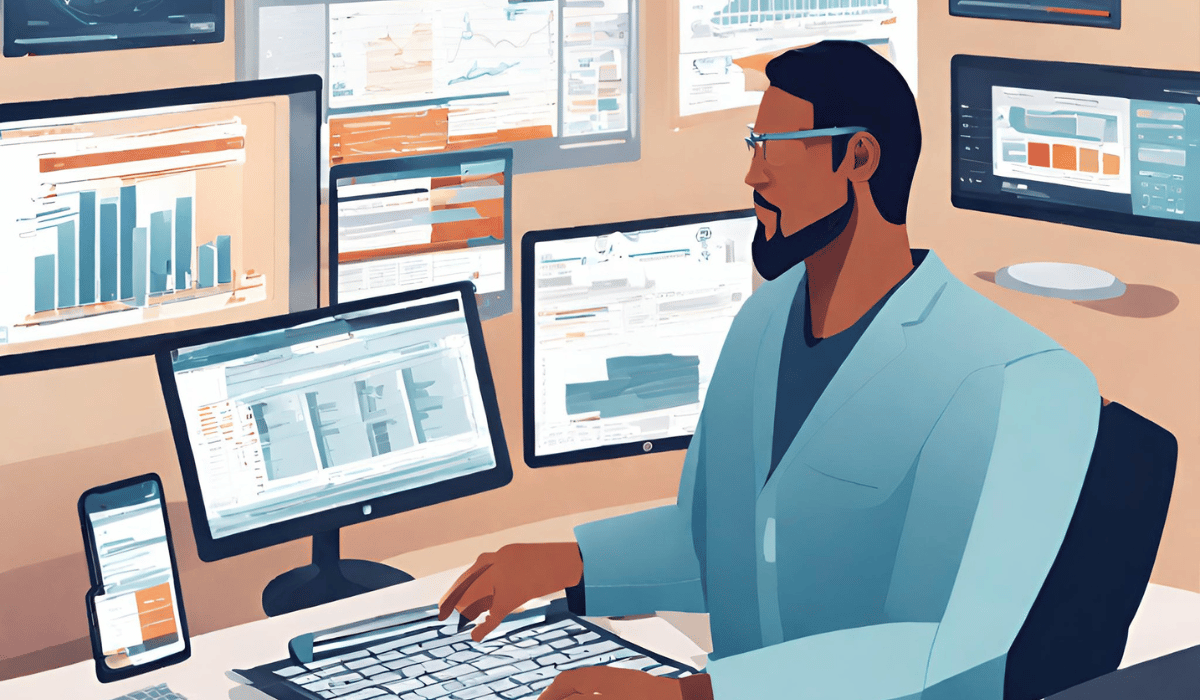Introduction
A security data analyst is a professional who specializes in analyzing data related to security incidents and threats. They are responsible for gathering, analyzing, and interpreting data from various sources to identify patterns and trends that could indicate potential security risks. The role of a security data analyst is critical in today’s world, where cybersecurity threats are becoming increasingly sophisticated and frequent.
Importance Of Security Data Analyst In Cybersecurity

The importance of a security data analyst in cybersecurity cannot be overstated. They play a vital role in identifying and mitigating potential security threats before they can cause significant harm. By analyzing data from various sources, including network logs, system logs, and user activity logs, they can recognize patterns and anomalies that could indicate a potential security breach. Moreover, security data analysts monitor security systems and identify any unusual activity. They use various tools and techniques to analyze data and identify potential threats, such as machine learning algorithms, data visualization tools, and statistical analysis methods. In addition to identifying potential threats, security data analysts play a crucial role in developing and implementing security policies and procedures. They work closely with other security professionals to develop effective security strategies and ensure that all security protocols are up-to-date and effective.
What Is Data Analyst Security?

A data analyst security is a professional who specializes in analyzing data related to security systems and protocols. They use their expertise in data analysis to identify potential security threats and susceptibilities and to make strategies to prevent security breaches. They also work closely with other security professionals to implement security policies and procedures and to certify that all security protocols are up-to-date and effective. Overall, data analyst security is critical in protecting sensitive data and preventing security breaches in organizations.
Skills And Qualifications Of A Security Data Analyst
A security data analyst should have a strong data analysis and information security background. Some of the key skills and qualifications for this role include:
Technical Skills
- Proficiency in data analysis tools and software
- Knowledge of information security principles and technologies
- Familiarity with database management and data warehousing
- Understanding of network security protocols and architectures
- Experience with data visualization and reporting tools soft Skills
- Strong analytical and problem-solving skills
- Attention to detail and accuracy
- Aptitude to work autonomously and as part of a team
- Excellent communication and interpersonal skills
- Flexibility and compliance with changing priorities and requirements
Education And Experience
- Bachelor’s or Master’s degree in Computer Science, Information Technology, or a related field
- Appropriate industry certifications such as CISSP, CISM, or CompTIA Security+
- 3-5 years of experience in security principles and technologies
- Experience with industry-standard security tools such as firewalls, intrusion detection/prevention systems, and vulnerability scanners
- Familiarity with regulatory compliance necessities such as HIPAA, PCI DSS, and GDPR
Analytical Skills
Strong analytical skills are essential to be successful in a security role. A security professional must be able to analyze data, identify patterns, and make informed decisions based on that analysis. Some key skills that are important for security professionals include:
- Critical thinking: the capacity to analyze information, assess arguments, and make broad decisions based on evidence
- Problem-solving: the ability to identify and solve complex problems in a timely and effective manner
- Attention to detail: the skill to identify small details that may be important in identifying security risks
- Communication: the ability to effectively communicate with team members, stakeholders, and clients
- Technical skills: proficiency in using various software and tools used in security analysis
- Adaptability: the ability to swiftly adapt to changes in technology and security threats
- Ethics: a strong understanding of ethical principles and the ability to make ethical decisions in difficult situations
By possessing these skills, security professionals can help protect organizations from cyber attacks, physical threats, and other security risks.
Communication Skills
Effective communication skills are essential for security professionals to effectively convey important information to stakeholders, clients, and team members. These skills include clearly and concisely explaining technical concepts and security risks, listening actively, and responding appropriately to feedback and concerns. In addition, security professionals must be able to communicate with an extensive range of individuals, including non-technical stakeholders and team members from different departments. This requires strong interpersonal skills and adapting communication styles to different audiences.
Certifications
Certifications are a valuable tool for security professionals to demonstrate their expertise and knowledge in specific security areas. Some popular certifications in the security industry include Certified Information Systems Security Professional (CISSP), Certified Ethical Hacker (CEH), and Comp TIA Security+. These certifications allow professionals to showcase their skills and commit to ongoing learning and professional development. It’s important to note that while certifications can be helpful, they should not be the sole measure of a security professional’s expertise. Real-world experience and a deep understanding of the industry determine a professional’s skill level. Additionally, keeping current on the latest security threats and technologies is essential in this constantly evolving field.
Responsibilities Of A Security Data Analyst
The primary responsibility of a security data analyst is to protect an organization’s digital assets by analyzing and interpreting data related to security threats. This includes identifying potential vulnerabilities, analyzing security incidents, and developing risk mitigation strategies. Other key responsibilities of a security data analyst may include the following:
- Collecting and analyzing data from various sources, including network logs, security devices, and other security-related data sources.
- Conducting risk assessments to find potential security threats and vulnerabilities.
- Developing and applying security policies and procedures to protect an organization’s assets.
- Collaborating with other IT professionals and business stakeholders to ensure that security measures are integrated into an organization’s operations.
- Staying up-to-date on the latest security threats and technologies to ensure an organization’s security measures remain effective.
A security data analyst is critical in protecting an organization’s digital assets and ensuring its operations remain secure. As a writing assistant, I can help you craft content that effectively communicates the importance of this role and the skills and knowledge required to succeed in it.
Tools And Technologies Used By Security Data Analysts
Security data analysts use various tools and technologies to perform their job duties. These may include:
- Security information and event management (SIEM) tools: SIEM tools collect and analyze security data from various sources, such as firewalls, intrusion detection systems, and antivirus software.
- Data visualization software: Data visualization software creates visual representations of security data, such as charts and graphs, to help analysts identify patterns and trends.
- Programming languages: Security data analysts may use programming languages like Python, R, and SQL to manipulate and analyze large datasets.
- Statistical analysis software: Statistical analysis software like SAS or SPSS may perform advanced statistical analysis on security data.
- Threat intelligence platforms: Threat intelligence platforms are used to gather and analyze information about potential security threats, like malware or phishing attacks.
- Cloud security platforms: Cloud security platforms monitor and secure cloud-based applications and services.
Challenges Faced By Security Data Analysts
Security data analysts face several challenges in their work, including:
- Data overload: Security data analysts have to deal with massive amounts of data, which can be overwhelming and time-consuming to analyze.
- Lack of standardization: There is no standard format for security data, making it difficult to compare and analyze data from different sources.
- Complexity of data: Security data can be intricate and difficult to understand, especially for non-technical stakeholders.
- Lack of expertise: Security data analysis requires high technical expertise, which can be difficult to find and retain.
- Rapidly evolving threats: Security threats constantly evolve, so security data analysts must stay current with the latest threats and trends.
- Limited resources: Security data analysts often have limited resources, like time, budget, and personnel.
Career Opportunities For Security Data Analysts
There are various career opportunities for security data analysts. Some of the common job titles for security data analysts include:
- Security Analyst: A security analyst monitors and analyzes security-related data to identify potential threats and vulnerabilities.
- Information Security Analyst: An information security analyst protects an organization’s information systems and data from unauthorized access, theft, and damage.
- Cybersecurity Analyst: A cybersecurity analyst is responsible for analyzing and assessing an organization’s cybersecurity posture and identifying potential risks and vulnerabilities.
- Threat Intelligence Analyst: A threat intelligence analyst is responsible for analyzing and assessing potential threats to an organization’s security and providing recommendations for mitigating those threats.
- Incident Response Analyst: An incident response analyst is responsible for answering security incidents and investigating the incident’s root cause.
Education And Training For Security Data Analysts

To become a security data analyst, one typically needs a bachelor’s degree in computer science, cybersecurity, or a related field. Additional certifications, such as the Certified Information Systems Security Professional (CISSP) or the Certified Ethical Hacker (CEH), may also be beneficial. Continuing education and training are also important for security data analysts to stay up-to-date with the latest security threats and technologies. This can include attending conferences, participating in webinars, and completing online courses or training programs. Additionally, many organizations offer internal training programs for their security teams to ensure they have the necessary skills and knowledge to protect their data and systems.
Steps To Become A Security Data Analyst
Becoming a security data analyst typically involves the following steps:
- Obtain a relevant degree: A bachelor’s degree in computer science, information technology, or an associated field is typically required to become a security data analyst.
- Gain experience: Many employers choose candidates with experience in the field, so it’s important to gain experience through internships, entry-level positions, or volunteer work.
- Develop technical skills: Security data analysts must have a strong understanding of data analysis tools, techniques, and programming languages such as Python and SQL.
- Obtain certifications: Industry certifications, like the Certified Information Systems Security Professional (CISSP) or Certified Ethical Hacker (CEH), can demonstrate expertise and enhance job prospects.
- Stay up-to-date: Continuing education and training is important to stay current with the latest security threats and technologies.
By following these steps, individuals can become qualified security data analysts and help organizations protect their valuable data and systems.
Tips For Success As A Security Data Analyst
As a security data analyst, there are several tips you can follow to ensure success in your role:
- Stay up-to-date on the latest security threats and vulnerabilities by regularly reading industry publications and attending relevant conferences and training sessions.
- Develop strong technical skills, including proficiency in data analytics software and programming languages commonly used in the field.
- Build relationships with key organizational stakeholders, including IT teams, business leaders, and security professionals, to better understand their needs and priorities.
- Practice effective communication skills, both written and verbal, to convey complex security concepts to non-technical stakeholders.
- Continuously improve your problem-solving skills by seeking out challenging security issues and working to develop innovative solutions.
By following these tips, you can become a valuable asset to your organization and help ensure the safety and security of its data and systems.
Hiring A Security Data Analyst: What Employers Look For?
When hiring a security data analyst, they typically look for individuals with a combination of technical and soft skills. Here are the qualities that employers may look for:
- Technical skills: Employers may seek individuals with experience in security information and event management (SIEM) tools, data analytics software, and programming languages like Python and R.
- Analytical skills: Security data analysts need to be able to analyze data and identify patterns and trends that could indicate a security threat.
- Communication skills: Security data analysts must be able to communicate their findings to other organization members clearly and concisely.
- Attention to detail: Security data analysts must be detail-oriented to identify potential security threats and vulnerabilities.
- Problem-solving skills: Security data analysts must think critically and develop creative solutions to security problems.
By possessing these qualities, individuals can increase their chances of being hired as security data analysts and contribute to protecting an organization’s valuable data and systems.
Conclusion
In summary, to become a successful cybersecurity professional, it is significant to stay updated with the latest security threats and technologies, continuously learn and improve your skills, understand the needs and priorities of your organization, and effectively communicate complex security concepts to non-technical stakeholders. By following these tips, you can become a valuable asset to your organization and help ensure the safety and security of its data and systems.
The role of a security data analyst is expected to become increasingly important as organizations continue to face growing cybersecurity threats. With the increasing amount of data organizations generate, security data analysts will be needed to analyze and interpret this data to identify potential threats and vulnerabilities. They will also develop and implement strategies to mitigate these risks and protect the organization’s data and systems. Additionally, as more organizations move towards cloud-based solutions, security data analysts will need to have a deep understanding of cloud security and be able to monitor and secure cloud environments effectively. Overall, the future outlook for a security data analyst is promising, with strong demand for skilled professionals in this field.
Frequently Asked Questions (FAQs)
What Is The Normal Salary Of A Security Data Analyst?
A security data analyst’s average salary varies depending on location, experience, and industry. Rendering to Glassdoor, the average salary for a security data analyst in the United States is around $83,000 annually. However, this can range from around $55,000 to over $120,000 per year, depending on the individual circumstances.
What Education And Experience Do I Need To Become A Security Data Analyst?
To become a security data analyst, you typically essential a bachelor’s degree in an associated field, such as computer science, information technology, or cybersecurity. Some employers may also need a master’s degree or relevant certifications. In terms of experience, it is common for employers to look for candidates with at least 2-3 years of experience in a related field such as data analysis, cybersecurity, or IT. Additionally, knowing programming languages such as Python or SQL can be beneficial in this role.
What Are The Most Effective Skills For A Security Data Analyst?
The most important skills for a security data analyst include the following:
- Data analysis: The ability to analyze large amounts of data and find patterns and trends is crucial for a security data analyst.
- Cybersecurity knowledge: A solid understanding of cybersecurity concepts and best practices is essential for this role.
- Technical skills: Proficiency in programming languages such as Python or SQL and experience with data visualization tools is important for a security data analyst.
- Communication skills: Communicating complex technical concepts to technical and non-technical stakeholders is critical in this role.
- Attention to detail: A security data analyst must have a deep eye for detail and be able to identify anomalies and potential security threats in data.
- Problem-solving skills: The ability to think critically and creatively to solve complex problems is essential for a security data analyst.
- Adaptability: The field of cybersecurity is constantly evolving, so a security data analyst must adapt to new technologies and threats quickly.
What Are The Most Commonly Used Tools And Technologies By Security Data Analysts?
The most commonly used tools and technologies by security data analysts include:
- SIEM (Security Information and Event Management) tools: These tools collect and analyze security-related data from various sources to identify potential threats.
- IDS/IPS (Intrusion Detection System/Intrusion Prevention System): These tools monitor network traffic for suspicious activity and can block or alert potential threats.
- Vulnerability scanners: These tools scan systems and applications for vulnerabilities that attackers could exploit.
- Forensic tools: These tools help security analysts investigate security incidents by collecting and analyzing digital evidence.
- Data visualization tools: These tools help analysts present complex data in a way that is easy to understand and identify trends or patterns.
- Threat intelligence feeds: These services provide up-to-date information on known threats and vulnerabilities, which can help security analysts stay ahead of potential attacks.
